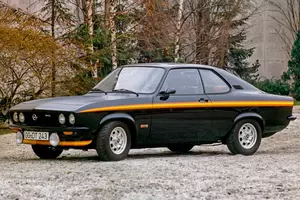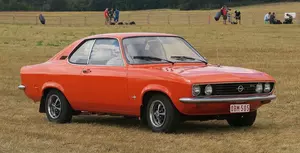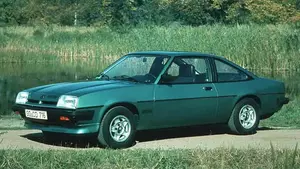
| Vehicle | Precise engine size | Difference from world average | Engine size to consumption ratio | Horsepower from 1 L | Engine size to 100 kg of weight |
|---|---|---|---|---|---|
| 1.3 S |
1.3 L (1297 cc) |
44.7% smaller | - | 58 hp from 1 L | 130 cc to 100 kg |
| 1.8 S |
1.8 L (1796 cc) |
23.4% smaller | - | 50 hp from 1 L | 180 cc to 100 kg |
| 2.0 S |
1.98 L (1979 cc) |
15.6% smaller | - | 51 hp from 1 L | 198 cc to 100 kg |
| 2.0 GSi |
1.98 L (1979 cc) |
15.6% smaller | - | 54 hp from 1 L | 180 cc to 100 kg |
| Vehicle | 1.3 S |
|---|---|
| Precise engine size | 1.3 L (1297 cc) |
| Difference from world average | 44.7 smaller |
| Engine size to consumption ratio | - |
| Horsepower from 1 L | 58 hp from 1 L |
| Engine size to 100 kg of weight | 130 cc to 100 kg |
| Vehicle | 1.8 S |
| Precise engine size | 1.8 L (1796 cc) |
| Difference from world average | 23.4 smaller |
| Engine size to consumption ratio | - |
| Horsepower from 1 L | 50 hp from 1 L |
| Engine size to 100 kg of weight | 180 cc to 100 kg |
| Vehicle | 2.0 S |
| Precise engine size | 1.98 L (1979 cc) |
| Difference from world average | 15.6 smaller |
| Engine size to consumption ratio | - |
| Horsepower from 1 L | 51 hp from 1 L |
| Engine size to 100 kg of weight | 198 cc to 100 kg |
| Vehicle | 2.0 GSi |
| Precise engine size | 1.98 L (1979 cc) |
| Difference from world average | 15.6 smaller |
| Engine size to consumption ratio | - |
| Horsepower from 1 L | 54 hp from 1 L |
| Engine size to 100 kg of weight | 180 cc to 100 kg |

| Vehicle | Precise engine size | Difference from world average | Engine size to consumption ratio | Horsepower from 1 L | Engine size to 100 kg of weight |
|---|---|---|---|---|---|
| 2.0 GSi |
1.98 L (1979 cc) |
15.6% smaller | - | 56 hp from 1 L | 180 cc to 100 kg |
| 1.3 S |
1.3 L (1297 cc) |
44.7% smaller | - | 58 hp from 1 L | 130 cc to 100 kg |
| 2.0 200 Rallye Gruppe |
1.98 L (1979 cc) |
15.6% smaller | - | 94 hp from 1 L | 198 cc to 100 kg |
| 2.0 200 |
1.98 L (1979 cc) |
15.6% smaller | - | 63 hp from 1 L | 180 cc to 100 kg |
| 1.8 S |
1.8 L (1796 cc) |
23.4% smaller | - | 50 hp from 1 L | 180 cc to 100 kg |
| Vehicle | 2.0 GSi |
|---|---|
| Precise engine size | 1.98 L (1979 cc) |
| Difference from world average | 15.6 smaller |
| Engine size to consumption ratio | - |
| Horsepower from 1 L | 56 hp from 1 L |
| Engine size to 100 kg of weight | 180 cc to 100 kg |
| Vehicle | 1.3 S |
| Precise engine size | 1.3 L (1297 cc) |
| Difference from world average | 44.7 smaller |
| Engine size to consumption ratio | - |
| Horsepower from 1 L | 58 hp from 1 L |
| Engine size to 100 kg of weight | 130 cc to 100 kg |
| Vehicle | 2.0 200 Rallye Gruppe |
| Precise engine size | 1.98 L (1979 cc) |
| Difference from world average | 15.6 smaller |
| Engine size to consumption ratio | - |
| Horsepower from 1 L | 94 hp from 1 L |
| Engine size to 100 kg of weight | 198 cc to 100 kg |
| Vehicle | 2.0 200 |
| Precise engine size | 1.98 L (1979 cc) |
| Difference from world average | 15.6 smaller |
| Engine size to consumption ratio | - |
| Horsepower from 1 L | 63 hp from 1 L |
| Engine size to 100 kg of weight | 180 cc to 100 kg |
| Vehicle | 1.8 S |
| Precise engine size | 1.8 L (1796 cc) |
| Difference from world average | 23.4 smaller |
| Engine size to consumption ratio | - |
| Horsepower from 1 L | 50 hp from 1 L |
| Engine size to 100 kg of weight | 180 cc to 100 kg |

| Vehicle | Precise engine size | Difference from world average | Engine size to consumption ratio | Horsepower from 1 L | Engine size to 100 kg of weight |
|---|---|---|---|---|---|
| 1.2 N |
1.2 L (1196 cc) |
49% smaller | - | 46 hp from 1 L | 133 cc to 100 kg |
| 1.2 S |
1.2 L (1196 cc) |
49% smaller | - | 50 hp from 1 L | 133 cc to 100 kg |
| 1.3 N |
1.3 L (1297 cc) |
44.7% smaller | - | 46 hp from 1 L | 144 cc to 100 kg |
| 1.3 S |
1.3 L (1297 cc) |
44.7% smaller | - | 58 hp from 1 L | 118 cc to 100 kg |
| 1.6 N |
1.58 L (1584 cc) |
32.5% smaller | - | 38 hp from 1 L | 158 cc to 100 kg |
| 1.6 S |
1.58 L (1584 cc) |
32.5% smaller | - | 47 hp from 1 L | 158 cc to 100 kg |
| 1.9 E |
1.9 L (1897 cc) |
19.1% smaller | - | 55 hp from 1 L | 190 cc to 100 kg |
| 1.8 S |
1.8 L (1796 cc) |
23.4% smaller | - | 50 hp from 1 L | 180 cc to 100 kg |
| 1.9 N |
1.9 L (1897 cc) |
19.1% smaller | - | 39 hp from 1 L | 190 cc to 100 kg |
| 1.9 S |
1.9 L (1897 cc) |
19.1% smaller | - | 47 hp from 1 L | 190 cc to 100 kg |
| 2.0 |
1.98 L (1979 cc) |
15.6% smaller | - | 45 hp from 1 L | 198 cc to 100 kg |
| 2.0 E |
1.98 L (1979 cc) |
15.6% smaller | - | 56 hp from 1 L | 198 cc to 100 kg |
| 2.0 S |
1.98 L (1979 cc) |
15.6% smaller | - | 51 hp from 1 L | 198 cc to 100 kg |
| 2.4 400 |
2.41 L (2410 cc) |
2.7% bigger | - | 60 hp from 1 L | 219 cc to 100 kg |
| Vehicle | 1.2 N |
|---|---|
| Precise engine size | 1.2 L (1196 cc) |
| Difference from world average | 49 smaller |
| Engine size to consumption ratio | - |
| Horsepower from 1 L | 46 hp from 1 L |
| Engine size to 100 kg of weight | 133 cc to 100 kg |
| Vehicle | 1.2 S |
| Precise engine size | 1.2 L (1196 cc) |
| Difference from world average | 49 smaller |
| Engine size to consumption ratio | - |
| Horsepower from 1 L | 50 hp from 1 L |
| Engine size to 100 kg of weight | 133 cc to 100 kg |
| Vehicle | 1.3 N |
| Precise engine size | 1.3 L (1297 cc) |
| Difference from world average | 44.7 smaller |
| Engine size to consumption ratio | - |
| Horsepower from 1 L | 46 hp from 1 L |
| Engine size to 100 kg of weight | 144 cc to 100 kg |
| Vehicle | 1.3 S |
| Precise engine size | 1.3 L (1297 cc) |
| Difference from world average | 44.7 smaller |
| Engine size to consumption ratio | - |
| Horsepower from 1 L | 58 hp from 1 L |
| Engine size to 100 kg of weight | 118 cc to 100 kg |
| Vehicle | 1.6 N |
| Precise engine size | 1.58 L (1584 cc) |
| Difference from world average | 32.5 smaller |
| Engine size to consumption ratio | - |
| Horsepower from 1 L | 38 hp from 1 L |
| Engine size to 100 kg of weight | 158 cc to 100 kg |
| Vehicle | 1.6 S |
| Precise engine size | 1.58 L (1584 cc) |
| Difference from world average | 32.5 smaller |
| Engine size to consumption ratio | - |
| Horsepower from 1 L | 47 hp from 1 L |
| Engine size to 100 kg of weight | 158 cc to 100 kg |
| Vehicle | 1.9 E |
| Precise engine size | 1.9 L (1897 cc) |
| Difference from world average | 19.1 smaller |
| Engine size to consumption ratio | - |
| Horsepower from 1 L | 55 hp from 1 L |
| Engine size to 100 kg of weight | 190 cc to 100 kg |
| Vehicle | 1.8 S |
| Precise engine size | 1.8 L (1796 cc) |
| Difference from world average | 23.4 smaller |
| Engine size to consumption ratio | - |
| Horsepower from 1 L | 50 hp from 1 L |
| Engine size to 100 kg of weight | 180 cc to 100 kg |
| Vehicle | 1.9 N |
| Precise engine size | 1.9 L (1897 cc) |
| Difference from world average | 19.1 smaller |
| Engine size to consumption ratio | - |
| Horsepower from 1 L | 39 hp from 1 L |
| Engine size to 100 kg of weight | 190 cc to 100 kg |
| Vehicle | 1.9 S |
| Precise engine size | 1.9 L (1897 cc) |
| Difference from world average | 19.1 smaller |
| Engine size to consumption ratio | - |
| Horsepower from 1 L | 47 hp from 1 L |
| Engine size to 100 kg of weight | 190 cc to 100 kg |
| Vehicle | 2.0 |
| Precise engine size | 1.98 L (1979 cc) |
| Difference from world average | 15.6 smaller |
| Engine size to consumption ratio | - |
| Horsepower from 1 L | 45 hp from 1 L |
| Engine size to 100 kg of weight | 198 cc to 100 kg |
| Vehicle | 2.0 E |
| Precise engine size | 1.98 L (1979 cc) |
| Difference from world average | 15.6 smaller |
| Engine size to consumption ratio | - |
| Horsepower from 1 L | 56 hp from 1 L |
| Engine size to 100 kg of weight | 198 cc to 100 kg |
| Vehicle | 2.0 S |
| Precise engine size | 1.98 L (1979 cc) |
| Difference from world average | 15.6 smaller |
| Engine size to consumption ratio | - |
| Horsepower from 1 L | 51 hp from 1 L |
| Engine size to 100 kg of weight | 198 cc to 100 kg |
| Vehicle | 2.4 400 |
| Precise engine size | 2.41 L (2410 cc) |
| Difference from world average | 2.7 bigger |
| Engine size to consumption ratio | - |
| Horsepower from 1 L | 60 hp from 1 L |
| Engine size to 100 kg of weight | 219 cc to 100 kg |

| Vehicle | Precise engine size | Difference from world average | Engine size to consumption ratio | Horsepower from 1 L | Engine size to 100 kg of weight |
|---|---|---|---|---|---|
| 1.3 N |
1.3 L (1297 cc) |
44.7% smaller | - | 46 hp from 1 L | 144 cc to 100 kg |
| 1.6 N |
1.58 L (1584 cc) |
32.5% smaller | - | 38 hp from 1 L | 158 cc to 100 kg |
| 1.9 N |
1.9 L (1897 cc) |
19.1% smaller | - | 39 hp from 1 L | 190 cc to 100 kg |
| 2.0 E |
1.98 L (1979 cc) |
15.6% smaller | - | 56 hp from 1 L | 198 cc to 100 kg |
| 2.0 |
1.98 L (1979 cc) |
15.6% smaller | - | 45 hp from 1 L | 198 cc to 100 kg |
| 1.2 N |
1.2 L (1196 cc) |
49% smaller | - | 46 hp from 1 L | 133 cc to 100 kg |
| 1.2 S |
1.2 L (1196 cc) |
49% smaller | - | 50 hp from 1 L | 133 cc to 100 kg |
| 2.0 S |
1.98 L (1979 cc) |
15.6% smaller | - | 51 hp from 1 L | 198 cc to 100 kg |
| Vehicle | 1.3 N |
|---|---|
| Precise engine size | 1.3 L (1297 cc) |
| Difference from world average | 44.7 smaller |
| Engine size to consumption ratio | - |
| Horsepower from 1 L | 46 hp from 1 L |
| Engine size to 100 kg of weight | 144 cc to 100 kg |
| Vehicle | 1.6 N |
| Precise engine size | 1.58 L (1584 cc) |
| Difference from world average | 32.5 smaller |
| Engine size to consumption ratio | - |
| Horsepower from 1 L | 38 hp from 1 L |
| Engine size to 100 kg of weight | 158 cc to 100 kg |
| Vehicle | 1.9 N |
| Precise engine size | 1.9 L (1897 cc) |
| Difference from world average | 19.1 smaller |
| Engine size to consumption ratio | - |
| Horsepower from 1 L | 39 hp from 1 L |
| Engine size to 100 kg of weight | 190 cc to 100 kg |
| Vehicle | 2.0 E |
| Precise engine size | 1.98 L (1979 cc) |
| Difference from world average | 15.6 smaller |
| Engine size to consumption ratio | - |
| Horsepower from 1 L | 56 hp from 1 L |
| Engine size to 100 kg of weight | 198 cc to 100 kg |
| Vehicle | 2.0 |
| Precise engine size | 1.98 L (1979 cc) |
| Difference from world average | 15.6 smaller |
| Engine size to consumption ratio | - |
| Horsepower from 1 L | 45 hp from 1 L |
| Engine size to 100 kg of weight | 198 cc to 100 kg |
| Vehicle | 1.2 N |
| Precise engine size | 1.2 L (1196 cc) |
| Difference from world average | 49 smaller |
| Engine size to consumption ratio | - |
| Horsepower from 1 L | 46 hp from 1 L |
| Engine size to 100 kg of weight | 133 cc to 100 kg |
| Vehicle | 1.2 S |
| Precise engine size | 1.2 L (1196 cc) |
| Difference from world average | 49 smaller |
| Engine size to consumption ratio | - |
| Horsepower from 1 L | 50 hp from 1 L |
| Engine size to 100 kg of weight | 133 cc to 100 kg |
| Vehicle | 2.0 S |
| Precise engine size | 1.98 L (1979 cc) |
| Difference from world average | 15.6 smaller |
| Engine size to consumption ratio | - |
| Horsepower from 1 L | 51 hp from 1 L |
| Engine size to 100 kg of weight | 198 cc to 100 kg |

| Vehicle | Precise engine size | Difference from world average | Engine size to consumption ratio | Horsepower from 1 L | Engine size to 100 kg of weight |
|---|---|---|---|---|---|
| 1.2 |
1.2 L (1196 cc) |
49% smaller | - | 50 hp from 1 L | 133 cc to 100 kg |
| 1.6 |
1.58 L (1584 cc) |
32.5% smaller | - | 47 hp from 1 L | 176 cc to 100 kg |
| 1.9 GT/E |
1.9 L (1897 cc) |
19.1% smaller | - | 55 hp from 1 L | 190 cc to 100 kg |
| 1.6 S |
1.58 L (1584 cc) |
32.5% smaller | - | 51 hp from 1 L | 176 cc to 100 kg |
| 1.9 S |
1.9 L (1897 cc) |
19.1% smaller | - | 46 hp from 1 L | 211 cc to 100 kg |
| Vehicle | 1.2 |
|---|---|
| Precise engine size | 1.2 L (1196 cc) |
| Difference from world average | 49 smaller |
| Engine size to consumption ratio | - |
| Horsepower from 1 L | 50 hp from 1 L |
| Engine size to 100 kg of weight | 133 cc to 100 kg |
| Vehicle | 1.6 |
| Precise engine size | 1.58 L (1584 cc) |
| Difference from world average | 32.5 smaller |
| Engine size to consumption ratio | - |
| Horsepower from 1 L | 47 hp from 1 L |
| Engine size to 100 kg of weight | 176 cc to 100 kg |
| Vehicle | 1.9 GT/E |
| Precise engine size | 1.9 L (1897 cc) |
| Difference from world average | 19.1 smaller |
| Engine size to consumption ratio | - |
| Horsepower from 1 L | 55 hp from 1 L |
| Engine size to 100 kg of weight | 190 cc to 100 kg |
| Vehicle | 1.6 S |
| Precise engine size | 1.58 L (1584 cc) |
| Difference from world average | 32.5 smaller |
| Engine size to consumption ratio | - |
| Horsepower from 1 L | 51 hp from 1 L |
| Engine size to 100 kg of weight | 176 cc to 100 kg |
| Vehicle | 1.9 S |
| Precise engine size | 1.9 L (1897 cc) |
| Difference from world average | 19.1 smaller |
| Engine size to consumption ratio | - |
| Horsepower from 1 L | 46 hp from 1 L |
| Engine size to 100 kg of weight | 211 cc to 100 kg |